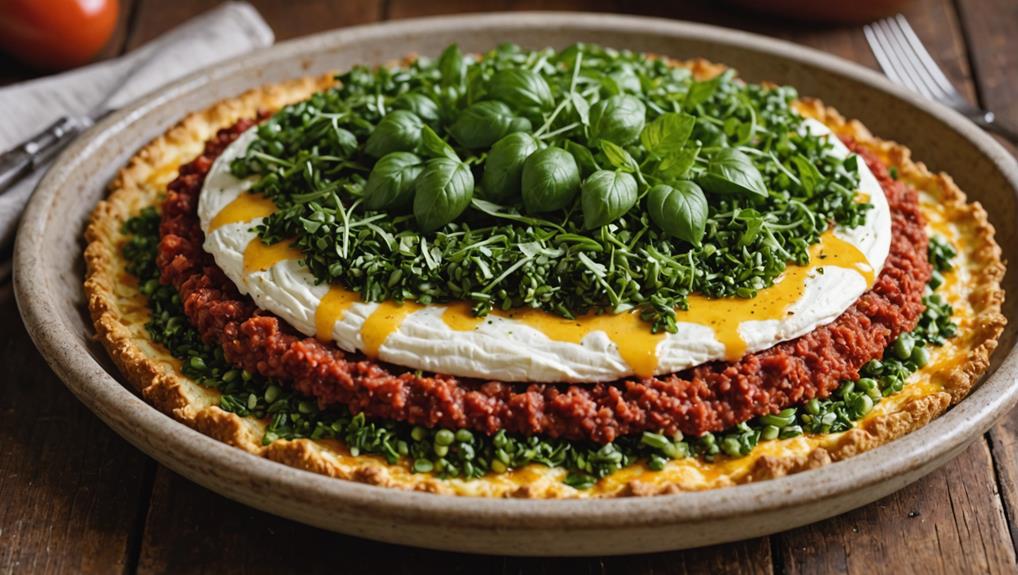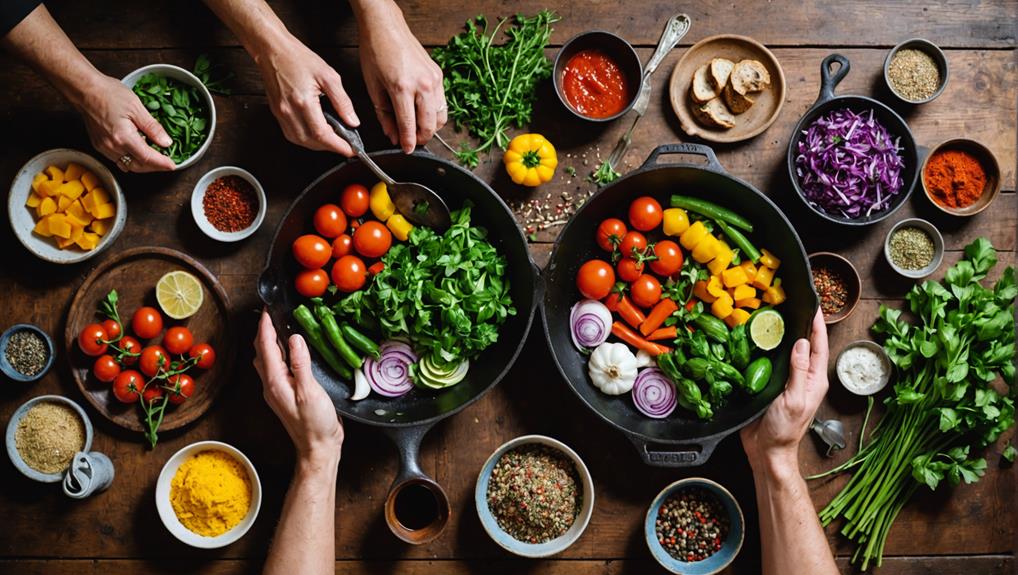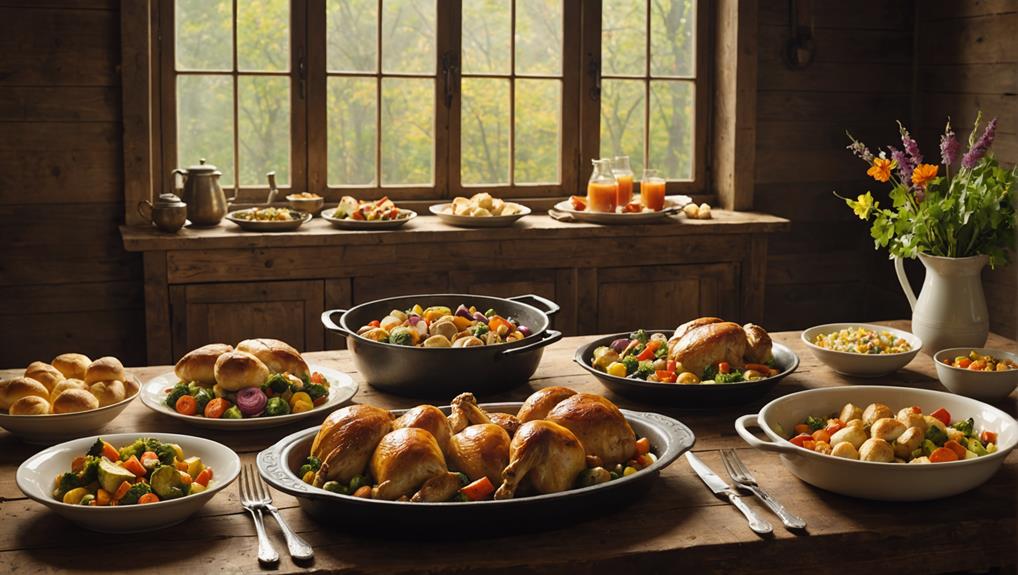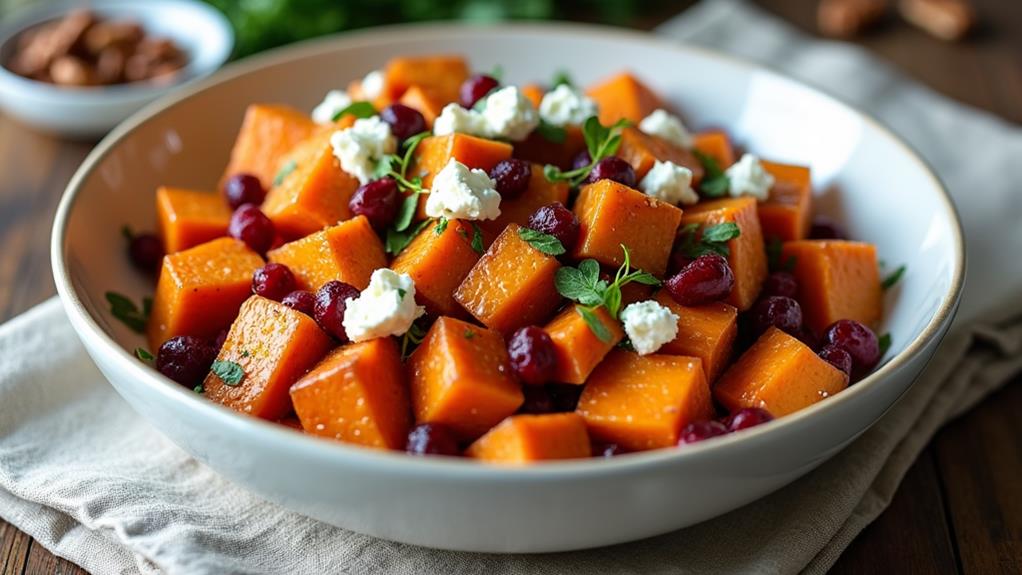To unveil savory secrets for mouthwatering home-cooked meals, focus on mastering the art of plating. Use vibrant ingredients and create height for visual appeal, while embracing negative space to highlight key components. Experiment with different plate shapes and strategic garnishes to elevate your presentation. Incorporate fresh herbs, citrus zest, and edible flowers as nature's jewelry for your dishes. Balance textures and colors by combining seasonal ingredients, creating a harmonious composition that's as pleasing to the eye as it is to the palate. By unleashing your inner food artist and focusing on quality ingredients, you'll transform ordinary meals into extraordinary culinary experiences. The journey to culinary excellence awaits your exploration.
Mastering the Art of Plating
Presentation is key when it comes to mastering the art of plating. To create a culinary masterpiece, you'll need to harness the power of color contrast. Use vibrant ingredients like fresh herbs or colorful vegetables to make your dish visually enticing.
The warm flavors of seasonal soups, such as butternut squash soup, can be beautifully complemented with a sprinkle of nutmeg or cinnamon for added visual allure. Don't just lay everything flat; create height and intrigue by stacking or arranging elements vertically. This adds dimension to your plate and captivates the eye.
Remember, less is often more. Embrace negative space on the plate to let your creation breathe and draw focus to the food itself. Enhance your dish with strategic garnishes, such as a pesto drizzle or microgreen sprinkle, to add both visual appeal and flavor complexity.
Don't be afraid to experiment with different plate shapes, sizes, and textures. The right plate can elevate your dish from ordinary to extraordinary.
As you practice these techniques, you'll develop an intuitive sense of balance and composition. Soon, you'll be transforming simple home-cooked meals into Instagram-worthy masterpieces.
With each plate, you're not just serving food; you're crafting an experience that delights all the senses.
Garnishes: Nature's Edible Jewelry
Every dish deserves a finishing touch, and garnishes are the perfect way to add that final flourish.
These high-quality ingredients not only elevate the visual appeal of your home-cooked meals but also introduce complementary flavors and textures. For instance, a vibrant Watermelon Feta Salad highlighted with mint (*savory flavor combos*) is a great example of how garnishes can enhance both appearance and taste.
When you're plating your culinary creations, consider using freshly chopped herbs like basil or parsley to brighten the dish and infuse it with an aromatic quality that'll enhance the overall dining experience.
For a refreshing burst of acidity that balances rich flavors, try incorporating citrus zest from lemons or limes. This simple addition can transform your dish from ordinary to extraordinary.
If you're feeling particularly innovative, experiment with edible flowers such as nasturtiums or pansies in your salads and desserts. These unexpected garnishes won't only make your plates visually stunning but also impart subtle, unique flavors.
Textures and Colors in Harmony

Beyond the finishing touches, the heart of an enticing meal lies in its textures and colors. As you embark on your diverse culinary journey, remember that textures and colors in harmony create a symphony for the senses.
For instance, incorporating seasonal ingredients like butternut squash mac and cheese can add both nutrition and a delightful color to your plate. Experiment with creamy, crunchy, and tender elements to elevate your dishes. You'll find that balancing these textures not only enhances the dining experience but also keeps your palate engaged throughout the meal.
Don't underestimate the power of vibrant colors in your cooking. Incorporate ingredients like red tomatoes, green basil, and golden olive oil to create visually stunning plates that hint at the variety of flavors and nutrients within.
Fresh herbs are your allies in this endeavor, adding both color and texture to your creations. When preparing pasta dishes, aim for that perfect al dente consistency to contrast with silky sauces, creating an irresistible texture combination.
Lastly, embrace seasonal vegetables to introduce a rich array of colors and textures to your home-cooked meals. By focusing on these elements, you'll transform ordinary dishes into extraordinary culinary experiences that delight both the eye and the palate.
Balanced Composition: The Visual Feast
The plate is your canvas, and the ingredients are your palette. As you embark on your culinary adventure, remember that balanced composition is key to creating a visual feast. Your home-cooked meals can rival restaurant presentations with thoughtful arrangement and attention to detail.
To achieve a stunning plate, consider these four essential elements:
- Color contrasts: Pair vibrant greens with deep reds for visual impact.
- Texture layering: Combine creamy sauces with crunchy toppings.
- Negative space: Allow areas of the plate to remain empty, highlighting key components.
- Height variation: Stack ingredients or add garnishes to create dimension.
By incorporating these principles, you'll transform your dishes into works of art. Use fresh basil and ripe tomatoes to add pops of color, and experiment with different textures to keep diners intrigued.
Don't overcrowd the plate; let each element shine by giving it room to breathe. Finally, build height to create an impressive visual appeal that will entice before the first bite.
With practice, you'll master the art of balanced composition, elevating your home-cooked meals to new heights of culinary excellence.
Unleashing Your Inner Food Artist

Unleash your culinary imagination and transform your kitchen into a creative studio. Embrace experimentation by trying new ingredients and cooking methods to discover unique flavor combinations that will tantalize your taste buds.
Don't be afraid to adapt traditional recipes, incorporating personal touches that reflect your culinary style. Remember, cooking is as much about the journey as it's about the end result.
To elevate your home-cooked meals from ordinary to extraordinary, focus on using fresh, high-quality ingredients. Ripe tomatoes and aromatic herbs can dramatically enhance both taste and presentation.
As you develop your skills, practice the art of plating by considering color, texture, and arrangement. This visual aspect can turn a simple dish into a feast for the eyes as well as the palate.
As you unleash your inner food artist, tap into your creativity and take joy in the process. Learn from each culinary endeavor, regardless of the outcome.
Elevate Your Culinary Presentation Game
Mastering the art of culinary presentation can transform your home-cooked meals into restaurant-worthy experiences. By focusing on visual appeal, you'll not only impress your guests but also elevate your own dining pleasure.
Start by utilizing contrasting colors and textures in your plating, incorporating vibrant vegetables alongside your main protein. Consider the height and arrangement of ingredients, creating layers to add dimension and sophistication to your dish.
To further enhance your culinary presentation game, follow these innovative tips:
- Experiment with garnishes: Use fresh herbs, microgreens, or edible flowers to add a pop of color and freshness.
- Invest in quality serving ware: Elegant plates or rustic boards can set the mood and enhance the overall dining experience.
- Master portion control: Pay attention to spacing and leave negative space to avoid overcrowding.
- Embrace social media inspiration: Explore food photography trends and plating techniques online for fresh ideas.
Frequently Asked Questions
How Can I Improve My Knife Skills for Better Ingredient Preparation?
To elevate your knife techniques, practice daily with proper grip and posture. Master various cuts like julienne and brunoise. Invest in quality knives and keep them sharp. Watch expert tutorials and experiment with innovative cutting methods.
What Are the Best Ways to Store Leftovers Without Compromising Flavor?
You'll master flavor preservation by using airtight containers and vacuum-sealed bags. Freeze portions quickly, label with dates, and reheat gently. For innovative storage, try layering ingredients separately or freezing in ice cube trays for easy portioning.
How Do I Adjust Cooking Times for High-Altitude Locations?
Imagine you're scaling a culinary mountain. For your altitude adjustments, increase cooking times by 15-25% per 3,000 feet above sea level. Lower oven temperatures slightly, add moisture to baked goods, and embrace innovative cooking techniques for high-altitude success.
What Are Some Budget-Friendly Alternatives to Expensive Ingredients?
You'll love these innovative ingredient swaps! Use beans instead of meat, frozen veggies for fresh, and Greek yogurt for sour cream. Don't forget to experiment with cheaper cuts of meat and seasonal produce for budget-friendly meals.
How Can I Make My Dishes More Aromatic Before Serving?
Picture yourself as a medieval alchemist. You can transform your dishes into aromatic wonders! Sprinkle fresh aromatic herbs just before serving, infuse oils with spices, or use a smoking gun for an avant-garde touch. Let your culinary creativity soar!
Final Thoughts
Did you know that 90% of people judge a dish by its appearance before tasting it? You've now unlocked the secrets to creating visually stunning meals that'll captivate your diners. From mastering plating techniques to harmonizing colors and textures, you're equipped to transform ordinary dishes into culinary masterpieces. Remember, every plate is your canvas, and each ingredient is a brushstroke. As you continue to practice, you'll develop your unique style, turning every meal into an unforgettable feast for the eyes and palate.















